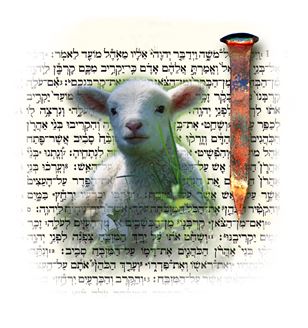Messianic Pictures in the Temple Sacrificial System

Messianic Foundations
Artwork by Steve Grier © 1997 RBC Ministries. Used by permission.
“… all things which are written about Me in the Law of Moses and the Prophets and the Psalms must be fulfilled.” (Luke 24:44 NAS)
These words of Jesus are both wonderful and mysterious. It is easy to see the messianic implications of a passage such as Psalms 22 or Isaiah 53, and the Savior’s great work in bringing those promises into reality.
Certainly even, we can comprehend passages of the Torah (the five books of Moses) which clearly refer to the Christ. No one can doubt the intent of Moses in Deuteronomy 18:15: “The LORD your God will raise up for you a prophet like me from among you, from your countrymen, you shall listen to him.” Even the Jewish sages—who do not yet recognize Jesus as Redeemer–acknowledge that Moses was speaking of the coming king of Israel, the Messiah.
Yet, what about a complex book like Leviticus? Do these pages truly speak of the Savior of all mankind? In Luke 24:27 we are told, “And beginning with Moses and with all the prophets, [Jesus] explained to them the things concerning Himself in all the Scriptures.” Our challenge in this document is to find Jesus, even in such a difficult and arduous book as Leviticus.
“Leviticus” in the Hebrew Bible is rendered Vayikra, which means, “and He called.” We leave Exodus with a Tabernacle emanating the awesome power of God with such intensity, that not even Moses could approach. Many rabbis teach that Vayikra began immediately where Exodus ends; that amidst the spectacular manifestation of His Shekinah glory—Vayikra, “and He called to Moses and spoke to him from the tent of meeting.” (Leviticus 1:1)
Only three times in Scripture does God call out to Moses. He often spoke with His servant, but in forty years of leading Israel from Egypt to Israel, rarely did He call to him. In each case, the matter for which Moses was summoned was deeply significant. In the case of Leviticus 1:1, the Supreme Being wanted to detail the ritual and regulations of the sacrificial system. A seemingly crude and barbaric service of bloodletting by today’s sterile, steak-wrapped-in-cellophane FDA standards, but a magnificent picture of the coming work of the Messiah.
“The Temple ritual always took place in broad daylight. The slaughter and smoke occurred in full view of the entire community–an act of the Kingdom of Light.”
While we may not appreciate the concept of sacrifices, they were the means by which our Creator brought life and light into the world. They should never be confused with occult ritual which is at war with the Kingdom of Life. “What fellowship has light with darkness?” (2 Corinthians 6:14)
With that said, let’s move ahead in our examination to discover Jesus in the book of Leviticus. Chapters 1-5 reveal five different types of sacrifices and, therefore, five different characteristics of the sacrificial system. There is a great deal of documentation on how the offerings where to be made, what was acceptable and what was not. We want to focus on why.
Category: Biblical Studies, Pneuma Review, Spring 1999


